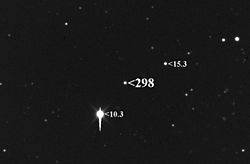298 Baptistina

Asteroid 298 Baptistina (apparent magnitude 15.2) near a mag 15.3 star.
|
|
| Discovery | |
|---|---|
| Discovered by | Auguste Charlois |
| Discovery date | 9 September 1890 |
| Designations | |
| MPC designation | (298) Baptistina |
|
Main belt, Baptistina family |
|
| Orbital characteristics | |
| Epoch 31 July 2016 (JD 2457600.5) | |
| Uncertainty parameter 0 | |
| Observation arc | 123.99 yr (45289 d) |
| Aphelion | 2.4805 AU (371.08 Gm) |
| Perihelion | 2.0475 AU (306.30 Gm) |
| 2.2640 AU (338.69 Gm) | |
| Eccentricity | 0.095630 |
| 3.41 yr (1244.3 d) | |
|
Average orbital speed
|
19.8 km/s |
| 209.69° | |
| 0° 17m 21.588s / day | |
| Inclination | 6.2884° |
| 8.2161° | |
| 135.004° | |
| Earth MOID | 1.06333 AU (159.072 Gm) |
| Jupiter MOID | 2.52351 AU (377.512 Gm) |
| Jupiter Tisserand parameter | 3.604 |
| Physical characteristics | |
| Dimensions | 13–30 km |
| 16.23 h (0.676 d) 16.23±0.02 hours |
|
| X-type | |
| 11.2 | |
298 Baptistina is an asteroid orbiting in the asteroid belt. It is the namesake of the Baptistina family. It was discovered on September 9, 1890, by Auguste Charlois of Nice. The source of its name is unknown. It measures somewhere around 13 to 30 kilometres (8 to 19 mi) in diameter. Although it has an orbit similar to the Flora family asteroids, Baptistina is an unrelated interloper. It was once considered a possible source of the impactor that caused the extinction of the dinosaurs, a possibility ruled out by the Wide-field Infrared Survey Explorer in 2011. (See Baptistina family.)
...
Wikipedia
